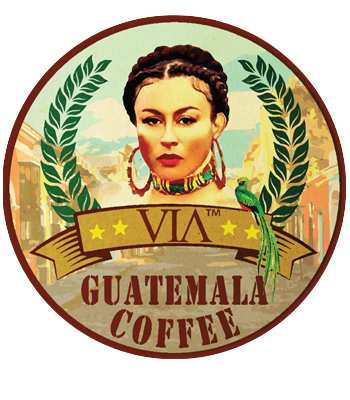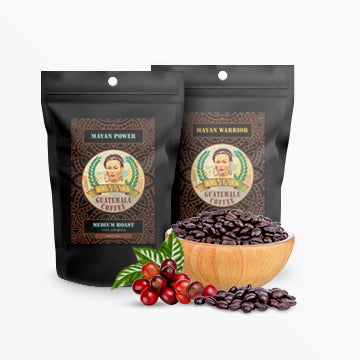Washed vs Natural Guatemalan Coffee: Processing Methods & Flavor Guide

Coffee processing methods can change everything about your morning cup. A single coffee cherry can become two completely different flavor experiences depending on how it's processed after harvest. At Via Guatemala Coffee, we've seen firsthand how the choice between washed and natural processing transforms our Guatemalan beans into distinct flavor profiles that coffee lovers either adore or completely avoid.
The difference isn't just technical coffee talk. It's the reason why some Guatemalan coffees taste bright and clean while others burst with fruity sweetness that might remind you more of wine than your typical morning brew.
Understanding Coffee Processing Basics
Coffee processing happens right after harvest when coffee cherries need quick attention to prevent spoilage. The goal is simple: remove the fruit flesh and dry the coffee seeds (what we call beans) to preserve them for roasting.
Two main methods dominate Guatemalan coffee production. Each creates dramatically different results in your cup.
The washed process removes fruit flesh immediately using water and fermentation. Natural processing lets cherries dry with the fruit intact, allowing extended contact between seeds and fruit sugars.
The Washed Process: Clean and Bright
Washed processing, also called wet processing, strips away the coffee cherry's outer layers within hours of picking. Here's exactly what happens:
Fresh cherries go through a pulping machine that removes the outer skin and most fruit flesh. The beans, still covered in a sticky layer called mucilage, get placed in fermentation tanks filled with water.
During 12-48 hours of fermentation, natural enzymes break down the remaining mucilage. Workers then wash the beans multiple times with clean water before spreading them on drying patios or raised beds.
Flavor Profile of Washed Guatemalan Coffee:
-
Bright, clean acidity
-
Clear flavor separation
-
Floral and citrus notes
-
Medium body
-
Crisp finish
This method dominates Guatemala's highland regions like Antigua and Huehuetenango. The high altitudes and consistent rainfall make water processing practical and effective.
At Via Guatemala Coffee, our washed Guatemalan beans showcase the terroir beautifully. You taste the volcanic soil influence without fruit flavors masking the coffee's natural characteristics. These coffees work perfectly for pour-over methods that highlight clarity and brightness.
The Natural Process: Bold and Fruity
Natural processing takes the opposite approach by keeping coffee cherries completely intact during drying. This ancient method requires careful attention but creates unique flavor complexity.
Freshly picked cherries spread directly onto drying beds or patios immediately after sorting. Workers turn them regularly to ensure even drying and prevent mold growth. The process takes 2-4 weeks depending on weather conditions.
During this extended drying period, fruit sugars penetrate the coffee seeds, creating distinctive flavor compounds you can't achieve any other way.
Flavor Profile of Natural Guatemalan Coffee:
-
Heavy body and syrupy mouthfeel
-
Intense fruit flavors (berries, tropical fruits)
-
Wine-like characteristics
-
Lower perceived acidity
-
Long, sweet finish
Natural processing works best in Guatemala's drier regions or during the dry season when consistent sunshine prevents mold issues. Producers need more space and labor since cherries require constant monitoring and turning.
Our natural process Guatemalan coffee delivers an entirely different experience. The fruit-forward profile makes these beans perfect for espresso or French press brewing where the full body shines through.
Climate and Geography Impact on Processing Choice
Guatemala's diverse microclimates heavily influence which processing method works best in each region. Highland areas like Antigua receive afternoon rains that make natural processing risky due to mold concerns.
Volcanic soil composition also affects processing decisions. Areas with better drainage can handle washed processing more easily since large amounts of water won't cause erosion problems.
Temperature variations between day and night help both processes. Cool nights slow fermentation in washed processing, creating more controlled flavor development. For natural processing, cool nights prevent over-fermentation while warm days maintain steady drying progress.
Coffee farms at different altitudes choose processing methods based on their specific conditions. Higher altitude farms often prefer washed processing since their beans already develop complex flavors from slower maturation at elevation.
Quality Control in Each Method
Both processing methods require strict quality control, but they focus on different critical points.
Washed Process Quality Factors:
-
Water quality must be clean and consistent
-
Fermentation timing needs precise monitoring
-
Drying must reach exactly 10-12% moisture content
-
Processing equipment requires daily cleaning
Natural Process Quality Factors:
-
Cherry selection becomes crucial (only perfectly ripe fruit)
-
Drying surface cleanliness prevents contamination
-
Regular turning schedule prevents mold growth
-
Weather monitoring determines daily drying decisions
We work directly with Guatemalan farmers who understand these quality requirements. Our relationships ensure consistent processing standards that translate into reliable flavor profiles in every batch.
Poor quality control in either method creates defective flavors that can ruin an entire lot. That's why we visit our partner farms regularly to verify processing practices meet our standards.
Economic Considerations for Farmers
Processing choice significantly impacts farm economics beyond just flavor outcomes. Washed processing requires substantial water infrastructure and more immediate labor after harvest.
Natural processing needs more space for drying and extended labor over several weeks. However, it uses no water and requires less expensive equipment.
Market prices often favor washed Guatemalan coffee because it meets specialty coffee buyers' preferences for clean, bright profiles. But natural processed coffees can command premium prices when quality exceeds expectations.
We pay fair prices for both processing methods because we understand the different costs involved. Our direct trade relationships ensure farmers can invest in quality improvements regardless of which method they choose.
Brewing Recommendations for Each Process
Your brewing method choice can maximize or minimize the differences between washed and natural Guatemalan coffee.
For Washed Guatemalan Coffee:
-
Pour-over methods (V60, Chemex) highlight clarity
-
Light to medium roasts preserve bright acidity
-
Finer grind sizes extract delicate flavors
-
Water temperature around 200°F works best
For Natural Guatemalan Coffee:
-
French press and espresso complement heavy body
-
Medium to medium-dark roasts balance fruit intensity
-
Coarser grinds prevent over-extraction
-
Slightly lower water temperature (195°F) prevents bitterness
Experiment with different brewing parameters to find your preference. The same coffee can taste completely different based on your preparation method.
Making Your Choice: Washed or Natural?
Your personal taste preferences should guide your choice between washed and natural Guatemalan coffee. Consider what you enjoy in other beverages and foods.
If you prefer wine, IPAs, or tart fruits, washed Guatemalan coffee might match your palate perfectly. The bright acidity and clean finish provide refreshing complexity without overwhelming sweetness.
Natural processed coffee appeals to those who enjoy rich desserts, dark fruits, or full-bodied red wines. The intense fruit flavors and heavy body create an indulgent coffee experience.
Many coffee enthusiasts keep both types on hand for different moods or times of day. Morning might call for bright, energizing washed coffee while afternoon deserves a rich, dessert-like natural processed cup.
Experience Both at Via Guatemala Coffee
Understanding processing differences helps you make informed choices about your coffee purchases. But reading about flavor profiles can't replace tasting the actual differences yourself.
We offer both washed and natural Guatemalan coffee options so you can experience these distinct processing methods firsthand. Our direct relationships with Guatemalan farmers ensure authentic examples of each processing style.
Visit our shop on Amazon to explore our current selection of washed and natural processed Guatemalan coffee. We provide detailed tasting notes and processing information for each option to help guide your selection.
Try both processing methods to discover your personal preference. You might find yourself appreciating the unique qualities each method brings to Guatemalan coffee's exceptional terroir characteristics.
Your perfect cup is waiting to be discovered through the fascinating world of coffee processing differences!






